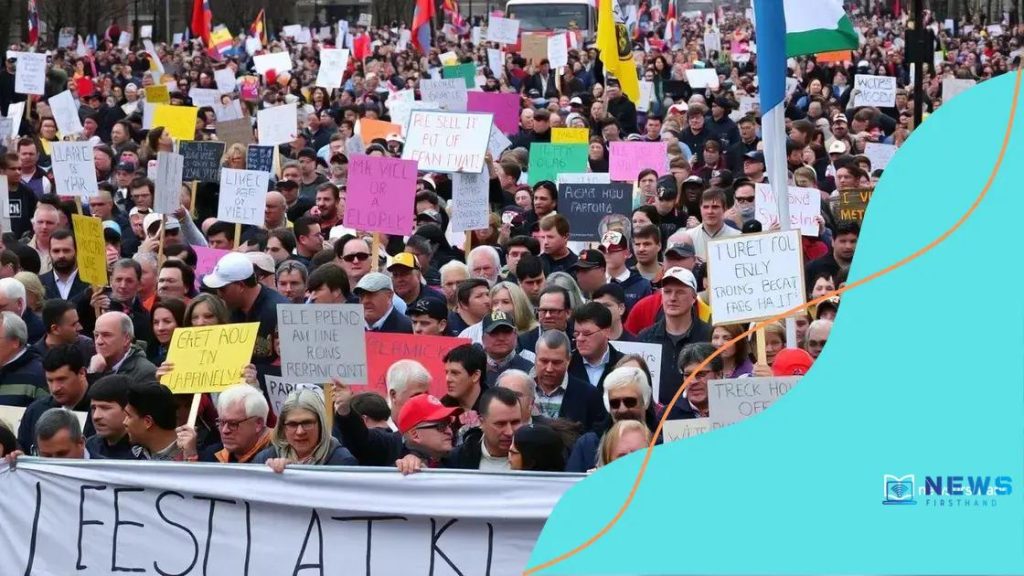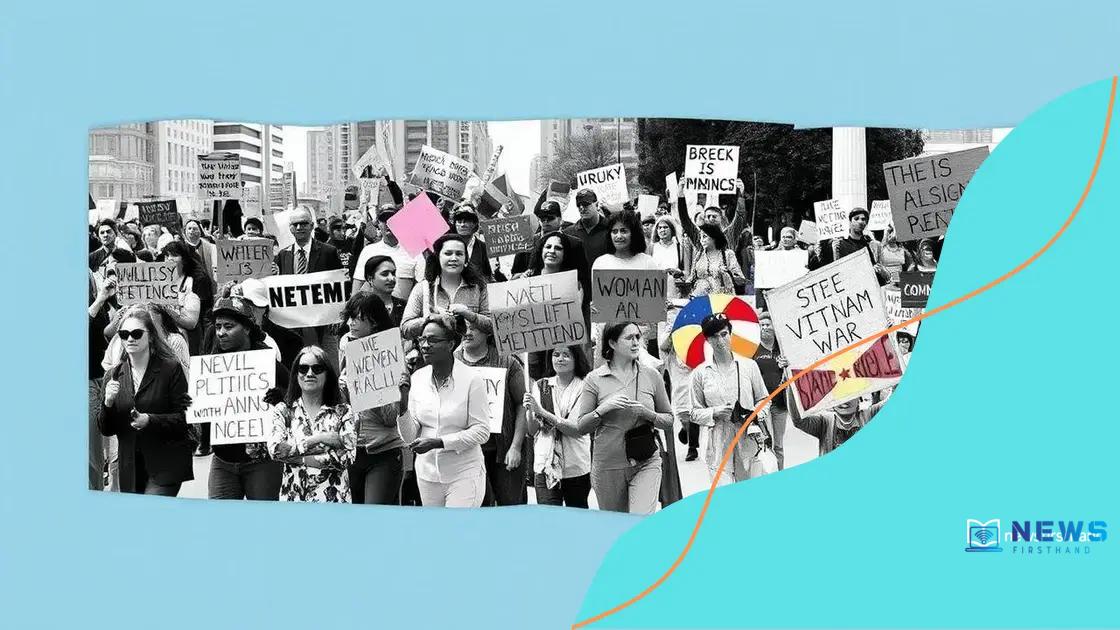Media framing of mass rallies: understanding perspectives

Media framing of mass rallies shapes public perception by emphasizing certain narratives, influencing how events are understood and discussed in society.
Media framing of mass rallies plays a crucial role in how events are perceived by the public. Have you ever noticed how the same event can be portrayed in vastly different ways depending on the outlet? Let’s dive into what influences these narratives.
The role of media in shaping rally narratives
The role of media in shaping rally narratives is significant. Media coverage influences how these events are perceived, creating lasting impressions. To understand this effect, it is essential to examine how different news outlets report on rallies.
Media Types and Their Impact
Various forms of media contribute to the framing of rally narratives. Each has its unique way of presenting information, affecting public perception.
- Television news tends to highlight dramatic visuals and emotional stories.
- Print media often provides in-depth analysis and context.
- Online platforms offer immediacy and diverse perspectives.
By differentially highlighting aspects of rallies, these media types can shape public opinion dramatically.
Case Studies of Media Framing
Examining specific cases can reveal how media framing occurs. For instance, during large protests, media might emphasize either the passion of the participants or the disruption caused by the event. The chosen angle can sway public sentiment.
Consider the coverage of environmental rallies. Some outlets focus on the message of sustainability, while others highlight counter-protests. Such discrepancies illustrate the substantial impact of framing.
Furthermore, social media plays a unique role in rally narratives. On platforms like Twitter and Facebook, real-time updates and personal stories can push specific narratives into mainstream discourse.
Influence of Social Platforms
The rise of social media has reshaped how rallies are discussed. Topics can quickly trend, and events can gain momentum based on how they are shared and framed online.
- User-generated content adds personal narratives and emotional connections.
- Hashtags help unify discussions and amplify messages.
- Influencers can sway public opinion by sharing their perspectives on rallies.
This creates a complex web of narratives that traditional media alone cannot capture.
Ultimately, the interplay between traditional media and social media affects how rallies are perceived. By understanding this dynamic, we can better appreciate the power of media in influencing public discourse.
Impact of framing on public perception
The impact of framing on public perception is profound. How events are presented in the media can greatly influence how people view those events. When narratives are framed in a particular way, they resonate differently with an audience, shaping attitudes and beliefs.
Understanding Framing Effects
Framing effects occur when a message is presented in a way that highlights certain aspects while downplaying others. This selective emphasis can steer public opinion in specific directions.
- Positive framing can lead to increased support.
- Negative framing may result in backlash or opposition.
- Contextual framing provides background, helping audiences understand complex issues.
For instance, if a rally is framed as a large, peaceful gathering advocating for change, it may attract more sympathy than if it is depicted as chaotic or disruptive.
Research on Public Perception
Studies show that the way media frames an issue significantly influences public attitudes. When people are presented with differing narratives, their reactions can vary drastically. Understanding these variations is key to grasping the complexities of public perception.
For example, research indicates that when environmental protests are highlighted as essential movements for climate justice, public support increases. However, when framed as radical actions threatening public order, support may diminish.
This duality in perception is crucial for organizers and activists. Knowing how to present their message can make a difference in garnering support for their causes.
The Role of Language in Framing
The language used in media reports also plays a vital role. Words convey emotion and can elicit specific responses from the audience. Describing a rally as a “march for justice” invites a positive sentiment, while labeling it as a “demonstration disrupting the city” can incite concerns.
- Emotion-laden words can enhance perceptions of urgency.
- Neutral language tends to downplay significance.
- Descriptive language can paint vivid pictures that sway opinions.
The choice of words, therefore, is not merely a matter of style but a powerful tool in shaping how events are perceived by the public.
Case studies of mass rallies in history

Case studies of mass rallies in history provide valuable insights into the ways public gatherings can influence social and political change. By analyzing these significant events, we can better understand the dynamics of crowd movements and their impact.
Key Historical Rallies
Throughout history, mass rallies have served as powerful tools for advocacy. They often bring people together around a common cause, raising awareness and prompting action. A few notable examples include:
- The Civil Rights March on Washington in 1963, which called for jobs and freedom.
- The Women’s March on January 21, 2017, advocating for women’s rights and social justice.
- The anti-Vietnam War protests of the late 1960s and early 1970s, shaping public opinion and policy.
Each of these rallies not only drew significant crowds but also created lasting impacts on legislation and societal attitudes.
The Role of Media Coverage
Media coverage of these events played a crucial role in shaping public perception. For instance, during the Civil Rights March, television broadcasts brought the struggles of African Americans into living rooms across the country, generating empathy and support.
Similarly, the imagery from the Women’s March showcased the solidarity of diverse groups advocating for equality. These images became iconic, reinforcing the messages of the rallies.
Lessons Learned from Protests
Analyzing past mass rallies reveals effective strategies for organizing and mobilizing. The ability to unite various groups under a common cause amplifies their voice.
Additionally, successful rallies often incorporate:
- Clear messaging that resonates with a broad audience.
- A strong visual presence through signs and banners.
- Engaging speakers who can inspire and motivate the crowd.
These elements contribute to the overall impact of the event, ensuring that the message reaches beyond the rally itself.
The influence of social media on rally framing
The influence of social media on rally framing has transformed how events are perceived and discussed. Social media platforms provide almost instant communication, enabling immediate reactions and interactions that shape narratives.
The Power of Instant Sharing
With the rise of platforms like Twitter, Facebook, and Instagram, rally organizers can share messages quickly and efficiently. This allows them to reach wider audiences, mobilizing support almost in real-time. As news spreads through social media, it creates a dynamic environment where narratives shift rapidly based on public sentiment.
- Visuals from rallies can go viral, capturing attention worldwide.
- Live streaming events allows viewers to participate remotely.
- User-generated content contributes diverse perspectives and stories.
This immediacy of information means that how a rally is framed can change before it even starts, depending on the online buzz surrounding it.
Framing Through Selective Highlighting
Social media also plays a crucial role in how rallies are framed. Users often highlight specific aspects of an event, focusing on elements that they find most compelling. This selective highlighting can lead to various interpretations of the same event.
For example, during a environmental rally, some may focus on peaceful protests and speeches, while others might highlight moments of tension or conflict. Such differences in framing can influence public perception. This highlights the significance of having a unified message to counteract potential negative portrayals.
Engagement and Interaction
Engagement on social media also shapes rally framing. Interactions among users, such as likes, shares, and comments, can amplify certain narratives. When people engage with content, they signal to algorithms what is significant, often leading to increased visibility.
- Hashtags unify discussions and help trending topics emerge.
- Influencers can sway opinions by sharing their insights on events.
- Comments create a dialogue that can further shape perceptions.
This engagement influences how rallies are discussed long after they occur, cementing their place in public discourse.
Debates around media bias and framing
Debates around media bias and framing are central to understanding how public opinion is shaped. These discussions focus on how news outlets present information and the implications of their choices.
Understanding Media Bias
Media bias occurs when a news source presents information in a way that favors a particular perspective. This can influence how events are perceived and can polarize public opinion.
- Selection bias highlights specific events while ignoring others.
- Language bias uses emotionally charged words to sway opinions.
- Framing bias presents information in a context that favors one interpretation.
As a result, people can develop differing views of the same event based on the media they consume.
Framing in News Coverage
The way news is framed significantly affects public understanding. For example, covering a protest as a “riot” versus a “peaceful demonstration” can lead to very different public reactions. Media framing not only describes an event but also shapes how it is perceived by the larger society.
Factors that influence framing include:
- The choice of images used, which can evoke emotions.
- The headlines that summarize stories, often influencing initial perceptions.
- The tone and style of the reporting can change audience engagement.
All these aspects contribute to how information is received and processed by the audience.
The Impact of Social Media on Bias
With the rise of social media, debates around media bias have intensified. Individuals can now share their perspectives, adding layers to the discussion about how news is framed.
This platform allows for rapid dissemination of information, but it also raises concerns about misinformation. As users share content, they may unintentionally spread biased narratives. This makes critical thinking essential for audiences consuming news.
The role of influencers and opinion leaders can sway public perceptions regarding media framing. Audiences often trust individuals they relate to over traditional news outlets, which complicates the matter further.
FAQ – Frequently Asked Questions about Media Framing and Bias
What is media bias?
Media bias refers to the tendency of news organizations to present information in a way that favors one perspective over another, influencing public opinion.
How does framing affect public perception?
Framing can significantly alter how an event is perceived by highlighting specific aspects and downplaying others, which can lead to varying interpretations.
What role does social media play in shaping narratives?
Social media allows for the rapid spread of information and diverse viewpoints, which can both reinforce and challenge traditional media narratives.
Why is critical thinking important in consuming media?
Critical thinking helps individuals analyze and question the information presented in the media, enabling them to engage more meaningfully and discern bias.





